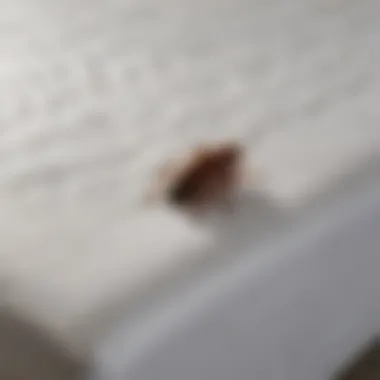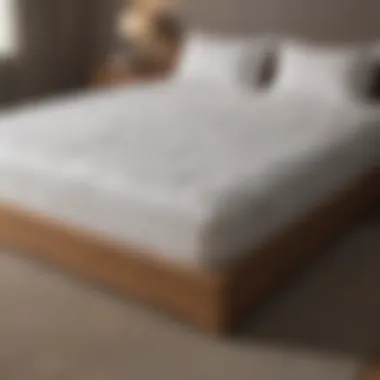The Role of Bed Bug Zip Mattress Covers in Pest Management


Intro
Bed bugs are small, nocturnal insects that feed on blood, typically from humans. Their presence can lead to discomfort, anxiety, and significant disruption in living spaces. As a result, managing these pests has become a priority for many homeowners and renters. One effective solution that has gained traction in pest management is the use of zip mattress covers. This article aims to provide a detailed analysis of how these covers function, their advantages, material composition, and maintenance recommendations. By understanding the role of zip mattress covers, readers can better equip themselves in the fight against bed bugs.
Understanding Pests
Definition of Pests
Pests are organisms that are considered troublesome to humans. In the case of bed bugs, they belong to the Cimex lectularius species. These insects can infest homes, hotels, and other environments where humans reside. Their elusive nature and rapid reproduction rate can make an infestation challenging to manage without appropriate intervention.
Importance of Pest Identification
Identifying pests is crucial for effective pest management strategies. Bed bugs often go unnoticed until their presence becomes severe. Being aware of the signs of an infestation—such as unexplained bites, shed skin, or dark spots on bedding—can significantly aid in early detection and response. Understanding their habits and lifecycle helps homeowners make informed decisions regarding prevention and treatment methods.
Prevention Techniques
Home and Garden Preventative Measures
For effective pest management, taking proactive measures is vital. In addition to using zip mattress covers, here are a few steps homeowners can take:
- Sealing entry points: Inspect your living space for cracks and crevices where bed bugs may enter. Ensure that windows and doors are tightly sealed.
- Regular cleaning: Frequent vacuuming can help remove any eggs, shed skins, or live bed bugs. Ensure to dispose of the vacuum bag immediately to prevent re-infestation.
- Laundering bedding: Regularly wash and dry bed linens and pillowcases in hot water. This will kill any existing bed bugs and their eggs.
Seasonal Prevention Tips
Bed bugs may not have a strict seasonal pattern, but awareness of seasonal changes can aid in prevention. For instance, travel during holidays can expose individuals to bed bugs in hotels. Following these tips can help:
- Inspect luggage: Always check luggage before bringing it indoors. Inspect seams and pockets for hidden bed bugs.
- Monitor guests: If hosting guests who travel frequently, encourage them to check their belongings before entering your home.
Integrating Zip Mattress Covers
Zip mattress covers serve as a dual purpose tool for pest management. First, they act as a barrier, preventing bed bugs from infiltrating the mattress. Second, they trap any existing bed bugs and eggs within, making it easier to eliminate them.
Material Composition and Features
These covers are typically made from high-density polyester or cotton blends, offering durability and comfort. They often feature a zipper that encloses the mattress entirely, which ensures no space is available for bed bugs to enter or escape. Look for covers labeled as "bed bug proof" for the most effective protection.
Advantages and Limitations
Advantages:
- Protection: They provide a secure barrier against bed bugs.
- Ease of Maintenance: Covers are washable, making it easy to keep bedding clean.
- Cost-effective: Investing in a good zip cover is a proactive and economical choice.
Limitations:
- Not a standalone solution: While effective, zip mattress covers should be used in conjunction with other pest management practices.
- Durability concerns: Over time, some covers may wear out or become less effective due to frequent washing, necessitating replacement.
Finale
Integrating zip mattress covers into your pest management strategy can significantly enhance your defenses against bed bugs. By understanding pests, employing preventive techniques, and maintaining cleanliness, homeowners can create an environment that minimizes the risk of infestation. Committing to these practices will lead to a safer and more comfortable living space.
"Effective pest management cannot rely on a single approach, but rather a combination of strategies that work together to combat pests."
In summary, being informed and active in prevention offers homeowners the best chance at managing bed bugs effectively. Through diligence and the right tools, such as zip mattress covers, it is possible to create a less hospitable environment for these unwanted invaders.
Understanding Bed Bugs
When dealing with bed bugs, it is important to have a solid understanding of their biology and behavior. This foundation helps in effectively managing and preventing infestations, especially when utilizing tools like zip mattress covers. Knowledge of bed bugs prompts better decisions regarding pest control strategies.


Identifying Bed Bugs
Identifying bed bugs accurately can be a challenge. Adult bed bugs are about the size of an apple seed, roughly 5 to 7 mm long. They are brownish-red and flat when unfed, but become swollen and darker after feeding. The nymphs, or immature bed bugs, are smaller and lighter in color. Active signs of an infestation include seeing these bugs during the night or upon waking, spotting tiny blood stains on sheets, or noticing dark spots of excrement. Regular checks of bedding and seams of mattresses are important to catch infestations early.
Life Cycle of Bed Bugs
Understanding the life cycle of bed bugs provides insight into their resilience and potential for rapid reproduction. A female bed bug can lay hundreds of eggs in her lifetime, typically ranging from 1 to 5 eggs per day. These eggs hatch in about 6 to 10 days, leading to various nymph stages before they reach adulthood in about 5 weeks. Given this rapid growth, even a small number of bed bugs can turn into a severe infestation if not addressed promptly.
Common Myths About Bed Bugs
Several myths surround bed bugs that can contribute to mismanagement. One common myth is that bed bugs are a sign of poor hygiene. In reality, bed bugs can find their way into any home, regardless of cleanliness. Another misconception is that eliminating all personal items infected with bed bugs is necessary. While some items may need to be discarded, many can be treated effectively without disposal. Understanding these myths is critical to developing an effective response plan against bed bugs.
The Need for Bed Bug Prevention
Bed bugs, despite their small size, can lead to major irritations for those living in infested homes. The necessity for prevention becomes obvious when one considers the extensive impact these pests can have. Bed bug prevention means taking proactive measures to avoid infestations, as treatment can be time-consuming and costly. Along with traditional methods, zip mattress covers serve as an effective preventative strategy.
Impact of Bed Bugs on Homes
When bed bugs invade a home, the ramifications extend beyond mere discomfort. Infestations can disrupt daily life, cause stress, and lead to sleepless nights. Bed bugs typically hide in small crevices, making them difficult to locate. Without proper prevention, they spread swiftly throughout a house. Their presence might lead to:
- Psychological Distress: The anxiety of dealing with bed bugs can be daunting. Affected individuals often live in fear of being bitten during the night.
- Financial Strain: Infestations typically require professional pest control services. This can lead to significant costs for homeowners.
- Damage to Property: While bed bugs do not cause structural damage, they can infest furniture and mattresses, potentially leading to the need for replacements.
Taking action with prevention tools like zip mattress covers can avoid these negative impacts.
Health Risks Associated with Bed Bugs
Beyond the discomfort of bites, bed bugs pose certain health risks. Their bites can result in skin irritation and allergic reactions for some individuals. Symptoms may include:
- Red, Itchy Bumps: The most common reaction to a bed bug bite is localized itching and swelling. However, some people can experience more severe allergies.
- Secondary Infections: Scratching the bites may lead to open wounds, which increases the risk of infections.
- Anxiety and Insomnia: The stress of an infestation can lead to sleep disturbances, contributing to long-term health complications.
In summary, understanding the need for bed bug prevention is crucial. By integrating solutions like zip mattress covers, homeowners can significantly reduce risk factors associated with these pests. It is a step towards ensuring a safe and comfortable living environment.
What are Zip Mattress Covers?
Zip mattress covers serve a critical function in pest management, particularly in the fight against bed bugs. These covers are designed to encase a mattress completely, creating a barrier that significantly reduces the risk of bed bug infestations. By understanding what zip mattress covers are and their role in pest prevention, homeowners can make informed decisions about how to protect their sleeping environments.
Material Composition
The effectiveness of zip mattress covers largely depends on their material composition. These covers are typically made of high-quality fabrics that are tightly woven to prevent bed bugs from penetrating through.
- Synthetic Fabrics: Many zip mattress covers use polyester blends. These synthetic materials are durable, resistant to wear, and easy to clean.
- Polyurethane Linings: Some covers incorporate polyurethane, which enhances water resistance. This feature adds another layer of protection against potential spills or leaks in the mattress.
- Breathable Design: It's important for the materials to be breathable, ensuring comfort during sleep while still offering protection from pests.
The right material not only provides a barrier against bed bugs but also ensures that the mattress remains in good condition over time.
Types of Zip Mattress Covers
Various types of zip mattress covers exist to cater to different needs and mattress types. Each type has its unique features:
- Protective Covers: Designed primarily to shield the mattress from bed bugs and allergens, these covers often feature a zipper that completely encloses the mattress. This design is essential for effective pest management.
- Waterproof Covers: These are particularly valuable for households with children or pets. The waterproof material prevents any spills from reaching the mattress, prolonging its lifespan.
- Cooling Covers: Some zip mattress covers are infused with cooling technology. This option is particularly appealing for those who tend to sleep hot.
- Allergy-Reducing Covers: These models include materials that help reduce dust mites and other allergens, contributing to a healthier sleep environment.
Understanding the different types of zip mattress covers enables homeowners to choose the one that best fits their specific requirements and circumstances.
How Zip Mattress Covers Work
Understanding how zip mattress covers function is crucial for effectively managing bed bug issues. These covers serve as a multifaceted solution in the battle against bed bug infestations. Their primary purpose is to provide a physical barrier, which helps in both prevention and containment of these pests.
Sealing in Bed Bugs


Zip mattress covers are designed to be tightly sealed. This impermeable quality is fundamental in trapping any bed bugs that may already be present on a mattress. When a mattress is encased in one of these covers, it prevents bed bugs from escaping once they have nested within. This containment minimizes the risk of the infestation spreading to other areas of the home. It is important to choose a high-quality zip cover; those with double-stitched seams and strong zippers offer the best protection.
A common misconception among homeowners is that simply encasing an infested mattress will eradicate the problem entirely. In reality, sealing bed bugs within the cover doesn’t eliminate them immediately. It is vital to monitor the mattress for a period of time after installation. For optimal results, the covered mattress should ideally remain sealed for at least a year, allowing the bed bugs trapped inside to die out without feeding.
Creating a Barrier
The barrier provided by zip mattress covers acts as a first line of defense against new infestations. Not only does it protect an existing mattress, but it also creates an environment that is less hospitable to bed bugs. These covers close off the primary habitat for bed bugs, which is typically the mattress and surrounding areas. With bed bugs unable to access the fabric and foam of a mattress, they are significantly deterred from taking residence.
In addition to offering protection to the mattress itself, these covers also safeguard against allergens caused by bed bug droppings and shed skins. For those with sensitivities, this is an essential benefit.
Consideration: It is crucial to regularly check and maintain the integrity of the cover. Any damage or wear can compromise its effectiveness, allowing bed bugs to infiltrate.
Advantages of Using Zip Mattress Covers
Zip mattress covers offer several benefits for those seeking to manage bed bug infestations effectively. These advantages make them a practical choice for homeowners and renters alike. Understanding these key points can significantly aid in making informed decisions when it comes to pest management strategies.
Ease of Use
One of the primary benefits of zip mattress covers is their ease of installation and use. These covers are designed to fit snugly over mattresses. Applying them requires minimal effort and typically only a few moments. Once installed, they do not necessitate any complicated maintenance.
To utilize zip mattress covers effectively, simply cover the mattress and secure it with the zipper. This provides a quick and efficient method to shield one's sleeping area from potential infestations. Additionally, they can be removed and replaced with relative ease when cleaning or replacing bedding. It is important to ensure the cover fits well, as gaps can undermine its effectiveness.
Long-Term Protection
Another significant advantage is the long-term protection that zip mattress covers provide. Once correctly installed, they can protect mattresses against bed bugs for years to come. This long-term barrier reduces the chances of an infestation spreading to the mattress, and hence, to the entire bedroom.
Moreover, these covers are typically durable and can withstand regular wear and tear. Choosing high-quality materials contributes to the lifespan of the cover. For homeowners, this reliability can mean peace of mind. A single investment can yield multiple years of protection.
Allergy Protection
Finally, zip mattress covers can also be beneficial for those with allergies. Many covers are made from hypoallergenic materials. This characteristic helps to limit dust mites, mold, and other allergens that may be present in mattresses. By opting for a zip mattress cover, individuals may experience fewer allergic reactions.
This protective feature is especially crucial for families with young children or individuals with existing health concerns. When maintaining a healthy sleeping environment, mattress covers serve a dual purpose of pest management and allergy protection.
In summary, zip mattress covers stand out as effective tools in the battle against bed bugs. They offer ease of use, long-term protection, and allergy defense, making them a valuable addition to any pest management strategy.
Understanding and utilizing these advantages can greatly aid homeowners in their efforts to create a safe and healthy living space.
Limitations of Zip Mattress Covers
While zip mattress covers offer significant advantages in the prevention of bed bug infestations, it is crucial to understand their limitations. Awareness of these limitations can help homeowners make informed decisions regarding their overall pest management strategies. These covers should not be viewed as standalone solutions but rather as a part of an integrated approach to pest control.
Not a Complete Solution
Zip mattress covers, while effective, do not provide a complete solution to bed bug problems. They may help trap existing bugs within the mattress and prevent new ones from entering, but they do not eliminate the entire infestation. Bed bugs can hide in various areas such as cracks in walls, floorboards, or even within adjacent furniture. Here are some key points illustrating these limitations:
- Residual Infestations: Even with a zip cover in place, bed bugs can remain in other areas of the home, continuing to reproduce and spread.
- Limited Reach: Zip covers protect only the mattress and box spring. Thus, they do not address other potential hiding spots like plush items, carpets, or wall spaces.
- Combination Needs: For effective pest management, combining zip mattress covers with routine inspections and extermination services is important. This creates a stronger overall defense against bed bugs.
Cost Considerations
Cost is another important factor to consider when discussing zip mattress covers. While they are relatively affordable compared to extensive pest control treatments, it is essential to understand the financial implications of using them.
- Initial Investment: Quality zip mattress covers can vary in price. Although investing in a good product can save money in the long run, there may still be a need for professional pest control services.
- Recurring Expenditure: Depending on the situation, homeowners may find themselves continually investing in new covers or pest control services, especially if effective treatment is not immediately achieved.
- Value vs. Effectiveness: As zip mattress covers offer partial solutions, it is worthwhile to assess their value against comprehensive pest control plans. Investing in multiple strategies may be more cost-effective than relying solely on bed bug covers.
"Zip mattress covers represent a protective measure, but they cannot replace thorough pest management practices."
Understanding these limitations helps frame zip mattress covers as a piece of the puzzle rather than the whole picture. A holistic approach will yield better results in controlling and preventing bed bug infestations.


Proper Use and Maintenance
Proper use and maintenance of zip mattress covers are crucial for their effectiveness in pest management. These covers not only prevent bed bug infestations but also prolong the life of your mattress. Understanding how to properly install and care for these covers can greatly enhance their protective capabilities.
Installation Tips
Installing a zip mattress cover must be done with precision. Start by ensuring that the mattress is clean and free of any debris or bugs. Follow these key steps during installation:
- Choose the Right Size: Ensure the cover fits your mattress snugly. It should completely encase the mattress.
- Zip it Up Properly: Close the zipper completely to avoid any gaps. A well-sealed cover will prevent bed bugs from entering or escaping.
- Check for Damage: Inspect the cover for any tears or defects before use. Any compromise in the material can allow pests to infiltrate.
- Secure the Edges: Some covers have additional straps or elastic edges. These features help to keep the cover in place and provide extra security against slipping.
- Consider Professional Assistance: If you are unsure about the installation, consulting a pest management professional may offer peace of mind.
Cleaning and Care
To maintain the integrity of your zip mattress cover, it is essential to follow proper cleaning and care guidelines. Here are practical steps:
- Regular Inspections: Periodically check your cover for signs of wear and tear. Make this a routine part of your cleaning schedule.
- Washable Materials: If your zip mattress cover is machine washable, follow the manufacturer's instructions regarding temperature and drying. Cold water is often recommended to preserve the material's quality.
- Spot Cleaning: For minor stains or spills, use a mild detergent and a damp cloth. Avoid harsh chemicals that may damage the fabric.
- Avoid Excessive Moisture: When cleaning, ensure that no excessive moisture is introduced, as this can encourage mold or mildew growth.
- Storing the Cover: If removing the cover for any reason, store it in a cool, dry place. Avoid direct sunlight which may degrade the fabric over time.
Keep in Mind: A well-maintained zip mattress cover can last for many years, offering ongoing protection against bed bugs. The investment in a quality cover and proper care is well worth the peace of mind it provides.
By adhering to these installation and maintenance tips, you not only ensure the effectiveness of bed bug zip mattress covers but also contribute to the overall health of your sleeping environment.
Complementary Pest Control Strategies
The integration of various pest control strategies is crucial in managing bed bug infestations. While zip mattress covers serve as an effective barrier, they should not be viewed as a standalone solution. Instead, they play a fundamental role in a larger pest management framework. Combining multiple approaches increases the effectiveness of pest control efforts and provides a comprehensive means to tackle bed bug issues.
Key strategies can amplify the utility of zip mattress covers:
- Regular inspections help to ensure that infestations are detected early.
- Professional extermination services can provide significant assistance in eradication when DIY methods fall short.
Using a combined approach enriches the pest management process and helps in maintaining a long-term bed bug-free environment.
Regular Inspections
Conducting regular inspections is vital in the quest for bed bug management. These inspections act as a proactive measure, allowing homeowners to identify potential infestations before they escalate. Inspections should be thorough and include examining common hiding spots such as seams of mattresses, bed frames, and upholstered furniture.
- Frequency: It is advisable to conduct inspections at least once a month, especially if there is a risk of bed bugs being introduced from external sources.
- Checklist: Create a detailed checklist to ensure that all potential areas are thoroughly inspected.
Regular inspections serve as an early warning system, enabling effective interventions before a small problem grows into a larger, more complex infestation.
Professional Extermination Services
When bed bugs have already established a notable presence, relying on professional extermination services becomes necessary. These experts offer a wealth of knowledge and experience, employing advanced techniques and products that are often not available to the average consumer.
- Assessment: Professionals begin with an assessment to determine the extent of the infestation and devise a customized treatment plan.
- Treatment Options: Strategies might include chemical treatments, heat treatments, or even steam cleaning, depending on individual circumstances.
Utilizing professional services ensures the effectiveness of eradication efforts, limiting the chance of repeat infestations. Aligning these services with the use of zip mattress covers provides a robust defense against the persistence of bed bugs in the home.
Culmination
In summary, the use of bed bug zip mattress covers plays a significant role in pest management. They serve as an effective preventive measure against bed bug infestations, offering multiple benefits for homeowners and renters. Understanding these advantages allows individuals to make informed decisions about their pest control strategies.
Recap of Key Points
- Sealing Capabilities: Zip mattress covers form a tight seal that encloses and kills existing bed bugs within the mattress. This function is essential in interrupting the life cycle of these pests.
- Material Composition: Typically made of durable, tightly woven fabric, these covers are designed to withstand wear and deter bed bugs from penetrating. The right materials can also resist allergens, providing a dual purpose.
- Long-Term Protection: Using zip mattress covers contributes to long-term defense against bed bugs. When combined with regular cleaning and inspections, they can significantly decrease the likelihood of an infestation.
- Maintenance Practices: Consistent cleaning and care are paramount to keeping these covers effective. Regular washing ensures that the protective barrier remains uncompromised over time.
Importance of Integrated Pest Management
Integrated pest management (IPM) is a multifaceted approach to controlling pest populations. The role of zip mattress covers cannot be overstated in this context. They represent one component of a broader strategy that includes regular inspections and professional extermination services. IPM aims to minimize reliance on chemicals while maximizing the effectiveness of various pest control methods.
Incorporating zip mattress covers into an IPM framework allows homeowners to achieve a balanced pest management strategy. While these covers effectively protect against bed bugs, they should never be considered a standalone solution. Rather, they work best alongside other pest control practices, enhancing overall effectiveness and reducing potential health risks.
"Prevention is better than cure. By integrating multiple methods, we can effectively manage pest problems and maintain a healthy living environment."
Ultimately, being proactive with measures like zip mattress covers, and combining them with proper care and inspection methods, empowers households to safeguard their spaces from the threat of bed bugs and other pests.



